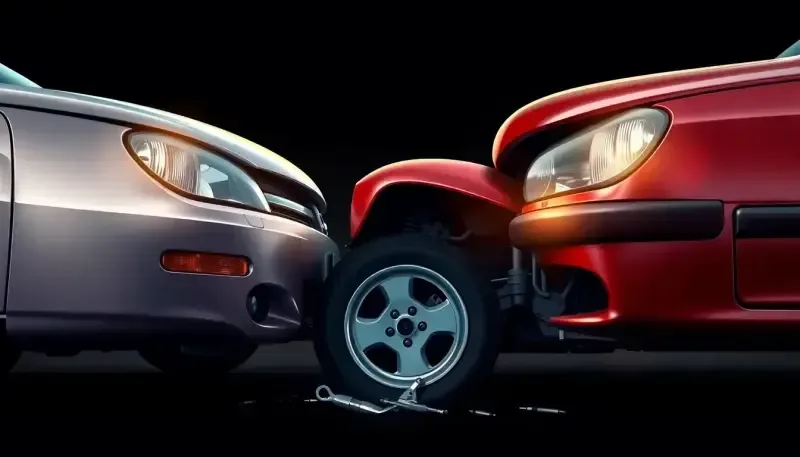Car accidents can range from minor fender benders to catastrophic collisions, each carrying its own implications. Understanding the differences between minor and serious car accidents is crucial for drivers, as it informs how to respond post-accident and what to expect in terms of legal and financial consequences. Let's dive into these distinctions to better equip you for any situation on the road.
Understanding Minor Car Accidents
A minor car accident typically involves low-impact collisions, resulting in minimal vehicular damage and, often, no serious injuries. Despite their seemingly harmless nature, these incidents can lead to insurance disputes or undiscovered medical issues that might arise later.
Common examples of minor accidents include:
- Fender benders occurring in parking lots or during heavy traffic.
- Low-speed rear-end collisions where the impact is minimal.
- Light side-swipes that cause cosmetic damage rather than structural harm.
Typical damages associated with minor accidents:
- Cosmetic vehicle damage such as scratches or small dents.
- Minor mechanical or structural issues, like misaligned bumpers.
- Injuries such as whiplash, sprains, or soft tissue damage that often do not require hospitalization.
It’s essential to document all injuries and damages, even if they seem minor, to protect yourself during any insurance negotiations.
What Constitutes a Serious Car Accident?
A serious car accident is characterized by high-impact forces that lead to significant vehicle damage and injuries necessitating emergency care. Such incidents often involve more complex legal and insurance matters due to the severity of the injuries and damages incurred.
Examples of serious accidents include:
- T-bone collisions at intersections where vehicles collide perpendicularly.
- High-speed highway crashes that can cause extensive damage.
- Head-on collisions that typically result in severe injuries or fatalities.
- Multi-vehicle pileups that complicate liability and insurance claims.
Typical damages from serious accidents encompass:
- Crumpled vehicle frames or total loss of the vehicle.
- Deployment of airbags, indicating a significant impact.
- Severe injuries like fractures, traumatic brain injuries, or spinal cord damage.
- Long-term disabilities, surgical interventions, and rehabilitation needs.
Given the complexity of medical treatments and legal implications, it is common for victims of serious accidents to seek legal representation.
Comparison of Minor and Serious Car Accidents
| Factor | Minor Accident | Serious Accident |
|---|---|---|
| Impact Speed | Low-speed impacts | High-speed, forceful collisions |
| Vehicle Damage | Cosmetic or superficial damage | Structural damage or total loss |
| Injuries | Mild, often not requiring hospitalization | Severe, life-threatening, or permanent injuries |
| Medical Costs | Low to moderate expenses | High expenses with potential long-term treatment costs |
| Insurance Claims | Typically straightforward | Often disputed or litigated |
| Police Involvement | Not always necessary | Required by law in most cases |
| Legal Complexity | Generally simple | Often requires legal assistance |
Assessing Accident Severity
Evaluating the severity of an accident involves several factors:
Vehicle Damage:
- Minor: Dents, scratches, or small cracks.
- Serious: Bent axles, deployed airbags, or frame damage.
Medical Assessment:
- Minor: Sprains, bruises, or whiplash.
- Serious: Head trauma, fractures, or internal injuries.
Traffic Impact:
- Minor: Minimal disruption to traffic flow.
- Serious: Road closures, involvement of emergency responders, and vehicle tows.
The severity of the accident influences whether police or emergency services are contacted, which can also affect citations and liability determinations.
Legal and Insurance Implications in Texas
Reporting Requirements
In Texas, it is mandated that drivers report accidents resulting in injury, death, or property damage exceeding $1,000. While minor accidents may not necessitate an official police report, filing one can aid in insurance documentation.
Insurance Claims Process
- For minor accidents: Claims usually involve repair costs and brief medical evaluations.
- For serious accidents: Claims can encompass long-term medical care, loss of wages, pain and suffering, and vehicle replacement.
Texas operates under a modified comparative fault rule, indicating that a driver may recover damages only if they are less than 51% responsible for the accident, with compensation adjusted according to the degree of fault.
Financial Implications of Car Accidents
Repair Costs:
- Minor: Typically under $2,000.
- Serious: Costs can range from $5,000 to over $50,000, or total loss value.
Medical Expenses:
- Minor: Usually involve basic outpatient care.
- Serious: May include emergency care, surgeries, rehabilitation, and ongoing medications.
Insurance Premiums:
- Both minor and serious accidents can lead to higher premiums; however, serious accidents tend to cause significant premium increases, policy cancellations, or non-renewals.
Steps to Take After Any Car Accident
Immediate Actions:
- Check for injuries among all parties involved.
- Move to a safe location away from traffic.
- Call 911 if injuries or major damage are present.
- Exchange insurance and contact details with the other driver.
- Document the scene with photographs, notes, and witness information.
For minor accidents:
- Consider filing a police report, even if it isn’t legally required.
- Notify your insurance company within 24 hours of the incident.
- Be vigilant for any delayed symptoms that may arise later.
For serious accidents:
- Seek immediate medical attention for any injuries sustained.
- Refrain from discussing details with the other party’s insurer without legal counsel.
- Contact a personal injury attorney as soon as possible for guidance.
The Role of a Lawyer in Car Accident Cases
While legal representation may not be essential for minor accidents, it becomes vital in serious cases. Attorneys can assist in numerous ways:
- Gathering and organizing evidence related to the accident.
- Establishing liability and fault.
- Negotiating with insurance companies to secure fair settlements.
- Accurately calculating damages and potential compensation.
- Filing personal injury lawsuits when necessary.
In Texas, the statute of limitations for filing a personal injury claim is two years from the date of the accident, making timely legal assistance crucial.
For additional insights into the implications of car accidents, consider watching this informative video:
The distinctions between minor and serious car accidents are critical for understanding your rights and responsibilities following an incident. Whether your experience was minor or severe, being informed can significantly impact your recovery and future protections on the road.

